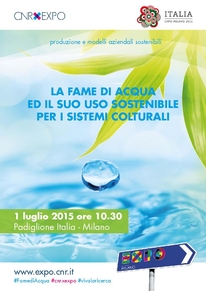The hunger of water and its sustainable use for cropping systems

Coordinator: Rossella Albrizio
Institute for Agricultural and Forest Systems in the Mediterranean (ISAFOM)
Interview to Riccardo D'Andria
What kind of event will be organized for Expò?
It will be structured in a dynamic way, with very brief presentation that will highlight the most salient points of the issue 'water' in agriculture. We made contact with the journalist Igor Staglianò of Ambiente Italia – RAI-3, which will be the moderator by coordinating the debate and involving the audience. It will be an active event, open to experts and non-experts, which will stimulate many focal point. We'll talk in global terms of water availability for agriculture, irrigation management from space, biodiversity to mitigate the issues of the use of water in agriculture as a result of climate change, precision irrigation and new technologies aimed to apply the correct irrigation scheduling.
Why the use of water in agriculture an actual issue?
Irrigation plays a key role in increasing crop yields and stabilize crop production in the agricultural systems. In the recent years many of the problems are due to the climate change, particularly in sensitive environments such as regions with a Mediterranean climate. Apart from rising temperatures, the decrease of precipitation and frequency of extreme events, it is important to know that the climate change affects also the distribution of rainfall throughout the year. So it is crucial to understand how this distribution is changing. Maybe the change does not alter substantially the total amount of precipitation in a given environment, but these may be not sufficient in some critical phenological stages to achieve adequate quantitative and qualitative yield production.
How new technologies can help to save water and money?
In a single environment, areas that require a different amount of water may be present, and generally they are. Sandy soils, for example, have low water retention therefore require frequent irrigation with low irrigation volume to avoid losses for percolation in the deep soil layers, soils with clay components have, instead, more water retention capacity. Therefore to have facilities that provide differentiated quantities of water in relation to the physical and chemical characteristics of the soil can offer a significant savings of the water resources and a better water use efficiency. Unfortunately, the fragmentation of properties in Italy makes it difficult to apply these technologies distribution, usually named as "precision irrigation", which instead are successfully applied in areas of extensive agriculture.
What kind of technologies are used?
The research has developed new sensors and techniques to estimate the amount of waterings and optimal intervention criteria. Just to give an example, it is already possible to manage irrigation from space. With the information gathered from satellites can get a precise idea of the vegetative state of a crop, and then using algorithms and data processing to calculate the water needs also in relation to climatic conditions. Another approach to achieve the correct irrigation scheduling may be through a DSS (Decision Support Systems) as the one developed in a study area derived from a collaboration between CNR-ISAFOM and University of Naples Federico II. Freely accessible online, the DSS provides the irrigation advice for a particular parcel in real time, being constantly connected to a network agrometeorological.
There is scarcity of water?
The available water for irrigation is continuously decreasing in terms of quantity and quality for both environmental conditions and the increase of the competition with other uses (industrial, civil, etc.). However, there is an increasing interest for the use of unconventional water that can, at least in part, support the classical reservoir, ie rivers, lakes, springs etc.. Indeed for example, municipal and industrial wastewater, properly treated, can be efficiently recycled and used for irrigation purposes. It represent a source not to be missed, which in many countries is already widely used. In Italy, despite the research is very advanced on this front, we are still behind with applications, even for a problem of normative adaptations. We might even have cases where waste water is enriched with useful nutrients for plants, and therefore properly treated could offer a positive enrichment of nutrients to plants. This topic will be discussed in the event that we are organizing for EXPO 2015.
How biodiversity can mitigate agricultural water problems of the planet?
Today, agriculture is called to review their agricultural cropping systems, both in terms of species more or less in terms of water demanding and in terms of selection of varieties that have more resistance and / or tolerance to water stress. It 'clear that a crop of olives and a crop of tomato have different water needs, but also within "tomato" or "olive" species some varieties are more resistant than others: for example, some cherry tomatoes type grown in the hills are more resistant to water stress than tomato for fresh consumption or other varieties for processing.
Why the farmer should computerize? After all it represents a cost..
The water and its distribution have rising costs. Just think the of the pumping and engineering of the water distribution system costs. A correct irrigation scheduling and adequate watering amount is an advantage in terms of economy, environmental sustainability and is a guarantee of stability and yield quality and quantity. Farmers should therefore adapt to management systems in order to save money and water resource. Another aspect concerns, for example, the cost of water charged to users by reclamation consortia. Some consortia apply costs in relation to actual consumption therefore also in these cases it is evident that the saving of water, without negative effects on the production, it is a goal to achieve.
ACTIONS
- Water and Food Security: Challenges and Solutions: Pasquale Steduto (FAO).
- Use of non-conventional water resources in agriculture: an unavoidable alternative: Antonio Lopez (IRSA CNR, Bari).
- Scenarios of climate change: adaptation of cropping systems and availability of water resources: Mladen Todorovic (CIHEAM, IAMB, Bari).
- The project AGROSCENARI: The potential of crops biodiversity for adaptation to future climate: Francesca De Lorenzi (CNR ISAFOM, Ercolano, Naples).
- Precision Irrigation for water conservation: Gabriele Buttafuoco (CNR ISAFOM, Cosenza).
- Irrigation management from space: from research to practical applications: Guido D'Urso (University Federico II, Portici, Naples).
- Can cyberinfrastructures support decisions on water management in agriculture at the local level (and beyond)? Angelo Basile (CNR ISAFOM, Ercolano, Naples).
- AquaTEK™: Produce more corn with less water. Federico Bertoli (Monsanto).
- DISTRILAKE - Integrated management of water resources distributed in the basins of the lakes in Lombardy Region: Rodolfo Soncini Sessa e Andrea Castelletti (Dipartimento di Elettronica, Informazione e Bioignegneria, HydroinformaticsLab Como, Politecnico di Milano).




